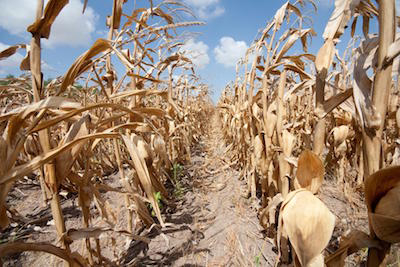
A corn crop is affected by drought in the Rio Grande Valley
August 15, 2022 - If you lived in Texas in 2011, this summer’s record heat and dry conditions may bring back memories of what resulted in the worst one-year drought on record in parts of the state. Texans may wonder what is being done to plan for the state’s water supply if a drought of that extent, or worse, were to happen again.
Regional Water Planning Process is Underway
The latest state water plan was adopted just over a year ago, but planning for the 2027 State Water Plan is well underway to ensure adequate water supplies for all Texans in times of drought. This process starts locally with 16 regional planning groups, each implementing a bottom-up approach to develop regional water plans that identify proposed strategies and projects to meet water supply needs over the next 50 years.
Regional planning groups consist of representatives from a variety of water users, ranging from industry, agriculture, environment, water utilities, groundwater management areas, the public, and more. These groups consider water demand and needs (potential shortages) in their region throughout the five-year planning cycle and identify, evaluate, and recommend strategies and projects to address them. Their final plan must reflect and respond to changes in population, water supplies, technological improvements, economic shifts, project viability, and state policy.
“Depending on the region’s geography and the water resources that are available, regional planning groups take their own path that fits their resources and the concerns they have related to water supply,” said Matt Nelson, Deputy Executive Administrator of Planning at the Texas Water Development Board (TWDB). “They're planning for themselves within the State’s framework, but the process is unique to their needs and the resources that they depend upon to be prepared for drought.”
Each planning group identifies potential water shortages under drought of record conditions and recommends water management strategies and projects with cost estimates and designated sponsors to address those potential shortages.
“Together, the planning regions recommended more than 2,400 water management strategy projects in the 2022 State Water Plan that must be implemented to meet water needs during a drought of record in the next 50 years,” said Nelson. “The success of each regional plan relies entirely on local project sponsors to implement, and, like any plan, they must be implemented to be effective.”
The TWDB has financial assistance programs to help sponsors implement projects. One in particular, the State Water Implementation Fund for Texas (SWIFT)* program, was created to solely fund state water plan projects and has committed over $9 billion to more than 60 projects across the state since 2015.
Utilizing localized data for water planning
Because Texas spans multiple geographies and climatic conditions, each region’s water resources and needs differ across the state. Annual rainfall amounts vary significantly from east to west, with Beaumont seeing an average of more than 60 inches of precipitation and El Paso seeing about 9 inches of precipitation, according to the National Oceanic and Atmospheric Administration. On top of that, drought conditions also vary by location and, together, these factors impact how each region plans for future risks.
The drought of the 1950s is the most significant statewide drought recorded in Texas’ history in terms of geographic extent, duration, and intensity and is considered the benchmark drought for statewide water planning. However, more recent localized droughts of record vary by river basin, so planning groups consider and plan for the most relevant drought for their region and water resources.
“Planning groups are aware that new drought conditions may happen again in some areas, and they are taking that data into consideration when they're planning,” said Nelson.
The five-year cyclical process allows the planning groups to incorporate new data and experiences to adapt accordingly. Regional planning groups can also plan for conditions that are worse than their drought of record, such as utilizing conservative (lesser) water source yield assumptions to provide some cushion in their plans.
Drought management strategies, which are measures implemented by local water providers to temporarily reduce water use, such as restricting car washing or lawn watering, can also be recommended by regional planning groups. In the 2022 State Water Plan, several regions made recommendations that collectively could reduce water use by up to 87,000 acre-feet per year in the immediate future and approximately 158,000 acre-feet per year by 2070 during a future drought of record.
How to get involved
Developing the state water plan is possible thanks to the hard work of hundreds of stakeholders who volunteer their time for the regional water planning process. The public is encouraged to participate by attending the open regional planning group meetings and by providing input at meetings and when the plans become available for public comment. A list of upcoming meeting dates and locations for each region can be found on the TWDB website.
“Public involvement is essential to the regional water planning process because local community members and water professionals know their regions best. You can have the most impact if you involve yourself early and often in the planning process, and we invite everyone to get involved as much as they can,” said Nelson.
*The SWIFT program includes two funds, the State Water Implementation Fund for Texas (SWIFT) and the State Water Implementation Revenue Fund for Texas (SWIRFT). Revenue bonds for the program are issued through SWIRFT.









